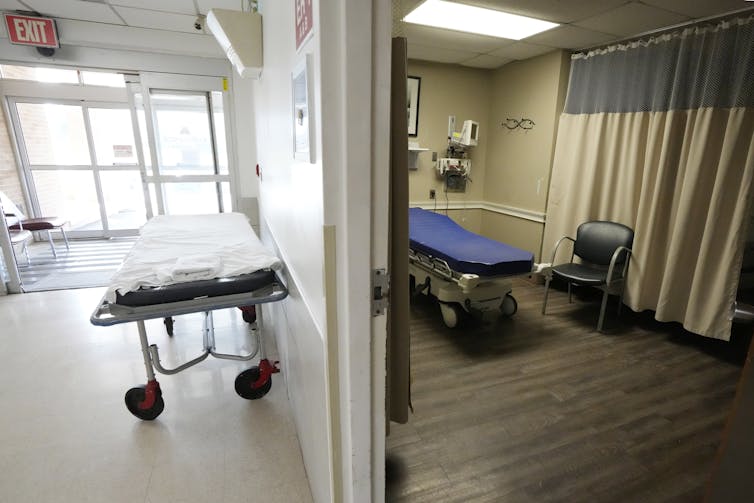
President Donald Trump’s signature promise during his campaign was to carry out the “largest deportation” operation in U.S. history, targeting all migrants “who violated the law coming into this country.”
Since anyone living in the U.S. without legal permission has broken civil immigration law, Trump would have to deport all of the 11 million to 12 million immigrants living without legal authorization in the U.S., not just people who have committed serious crimes. Most immigrants living in the country illegally have been here longer than 10 years, so many longer-term residents would be deported.
Trump has claimed that his election victory gives him a “powerful mandate” for such actions. But what do the American people really think about mass deportation?
News outlets like CBS and Scripps News have been reporting since mid-2024 that a majority of Americans support Trump’s plans to deport most or all undocumented immigrants.
These stories rely on some polls during 2024 that showed majority support for mass deportation. Meanwhile, other polls in 2024 found public support for deportation below 40%.
I am a psychologist with expertise in survey research and the influence of political ideology on people’s beliefs about news events. And I believe the key to making sense of these conflicting polls lies in understanding the psychological principles that underlie opinion polling.
Conflicting polls
Extensive psychological research research demonstrates that people make better decisions about complex, high-stakes problems when they think about and compare multiple courses of action, instead of narrowing in on one option.
When it comes to deportation, the main policy alternative offered by presidents as far back as George W. Bush has been allowing immigrants to become legal permanent residents if certain conditions are met, like passing a background check.
Because of this, Pew Research, a prominent pollster, suggests that the best way to determine how people feel about issues like mass deportation is to give them a question that forces them to choose between deportation and something else – in this case, legalization.
For example, one July 2024 poll using a “forced-choice” question asked people whether they’d rather see “a way for undocumented immigrants who meet certain requirements … to stay here legally” or “a national effort to deport and remove all illegal immigrants” from the U.S.
Another type of question used by pollsters focuses people’s attention on only one choice by asking them how much they support a policy like deportation, but without mentioning alternatives. Polls that follow this approach ask people’s opinion of deportation in one question, and their opinion of legalization in another.
This is not ideal because research shows it can lead people to exaggerate their support for the named policy.
What the polls say
In total, I found 14 polls conducted during the past eight years that measured Americans’ opinions on both mass deportation and legalizing status. I dropped two from my analysis because they had questions worded in biased language.
The findings from the remaining 12 polls are representative of the diverse demographics of the U.S.
Graph 1 present the results from the eight polls that used a single forced-choice question. I believe these polls give the best picture of how Americans as a group feel about the two immigration policies.
These polls suggest that over the past eight years, Americans’ overall support for mass deportation has increased from around 22% to around 44%. Meanwhile, support for legalizing immigrants’ status has decreased from about 77% to 55%.
However, all four polls conducted in 2024 find support for legalizing status to be above 54% and support for deportation below 45%.
Graph 2 shows the results of the four polls that used separate questions to assess opinions about deportation and legalization.
This chart clearly demonstrates the problem with asking people to rate their support for deportation and legalization in separate questions. Two polls, both taken in the past year – one by Gallup, the other by Times/Siena – found that a majority of respondents supported deportation and that the same group of respondents supported legalization in equal or even greater numbers.
Consider the October 2024 poll where 57% of respondents supported deportation and 57% supported legalization. These percentages add up to more than 100% because many people in the group said they supported both policies. Since mass deportation and general legalization are polar opposites, people who support both policies should not be considered to strongly support either policy.
For this reason, the separate questions technique does not yield good absolute information about the percentage of people who support either deportation or legalization. However, it does give useful relative information like which policy a group supports more and how opinions change over time.
Keeping this in mind, the results of the 12 polls I analyzed indicate that people favored legalizing immigrants’ status over deportation. Eleven polls, including five taken since 2024, showed this pattern. Overall public support for deportation has actually increased since 2016, while support for legalization has decreased.
However, these changes in opinion over time do not hold true for all Americans.
Americans are polarized about immigration
The poll results I’ve discussed so far are averages calculated based on the responses of everyone who responded to the poll. But group averages don’t tell the whole story on any issue – especially when opinions differ widely within a group, as they do with immigration. So let’s look at the results for Republicans and Democrats separately.
Graph 3 breaks down the results by party for the eight polls that used the best practice: forced choice question.
During Trump’s first term, from 2017 to 2020, just over half of Republicans supported legalization; just under half supported deportation. Only within the past year has Republican opinion shifted, with about 70% now supporting deportation.
In contrast, Democrats’ opinions have remained steady for eight years, with about 90% supporting legalization and 10% favoring deportation.
In other words, the apparent shift toward greater support for deportation shown in Graphs 1 and 2 occurred only among Republicans – not for Americans as a whole.
A mandate to legalize
Despite the recent uptick in Republican support for mass deportation, a clear majority of people in the U.S. would rather give undocumented immigrants a path to legal status than have them deported. This has remained true for eight years.
Polls that seem to contradict this conclusion by showing majority support for mass deportation have used the less reliable separate-questions technique. These results are questionable because these poll respondents voiced equal or stronger support for legalizing immigrants’ status.
If Trump has a “powerful mandate” on immigration, my research shows, it’s for getting legal authorization for immigrants who’ve lived in the U.S. a long time without it – not deporting them.![]()
Leo Gugerty, Professor Emeritus in Psychology, Clemson University
This article is republished from The Conversation under a Creative Commons license.


















 Según los CDC, algunas personas tienen mayor riesgo de enfermarse gravemente a causa de los virus respiratorios, estas incluyen a:
Según los CDC, algunas personas tienen mayor riesgo de enfermarse gravemente a causa de los virus respiratorios, estas incluyen a: